Influences impacting digital marketing education now and industry and academia in the future were highlighted during the Spring 2019 Stukent Digital Summit on March 1.
The conference — a third such summit presented by Stukent — brought together seven speakers and an audience of educators from around the world for insights, answers, and ideas on teaching digital marketing. Speakers drew on experience as marketing professionals and as seasoned instructors.
Following is a recap of what was shared during the nearly four hours of instruction.
Stuart Draper
Resources, Invitation, Ideas
Available scholarship and grant funds, an upcoming conference, and resources for staying up on digital marketing were all part of the conference’s first presentation, given by Stuart Draper, the founder and CEO of Stukent.
He let attendees know of financial resources available to both instructors and students, including the Stukent Research Grant, which will provide six $500 awards to support educators in furthering their research. The grant is in keeping with Stukent’s mission to help educators help students help the world. He also spoke of the Stukent Entrepreneur of the Year Scholarship, which makes available six $500 awards, three of those for high schoolers and three for higher education students.
Draper also talked of this summer’s ProfCon 2019, the first in-person conference from Stukent. The event is scheduled for June 19-21 in West Yellowstone, Mont.
Also part of Draper’s presentation was a set of suggested marketing websites to check out, including SearchEngineLand.com, SocialMediaExaminer.com, SearchEngineJournal.com, and the Google Digital Garage site.
During the presentation, Draper also shared ideas on grading student performance in the Stukent Mimic Pro simulation, recommending that more weight be given to participation than to the end result. He also encouraged instructors to give attention to landing pages and discussing ad decisions when instructing students relative to work in the simulation.
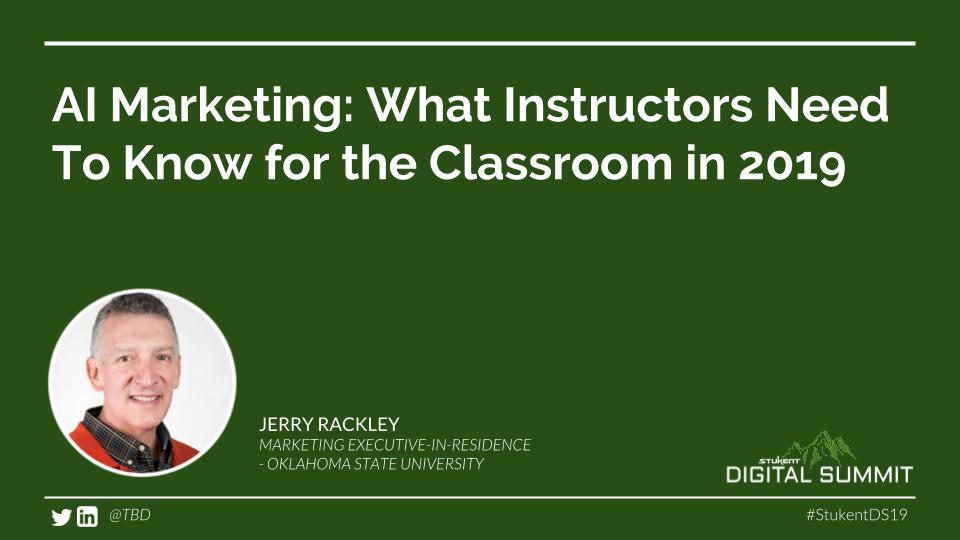
Jerry Rackley
Marketing executive-in-residence, Oklahoma State University
The next presenter was Jerry Rackley, the marketing executive-in-residence in the School of Marketing and International Business at Oklahoma State University. He set his topic, artificial intelligence (AI) marketing instruction in the classroom, in this context: “I think any of us who are teaching digital marketing or do digital marketing in practice understand how fast it changes.”
While AI’s position in the marketing efforts of businesses has not yet fully emerged, Rackley talked of its current and real presence in marketing discussions and of its predicted future. After acknowledging the hype that AI has received in the marketing space, he said, “I think the place to start for us who want to think about introducing AI into our classrooms is to understand where AI is in terms of all that hype.”
He shared with conference attendees examples of what AI can do for marketing, including the creation of personas for improved lead generation and the personalization of content.
Rackley indicated that classroom instruction on AI is not so much about students developing AI but more about students understanding AI’s capabilities. Specifically, he suggested that classroom instruction include the types of, marketing applications of, limitations of, and barriers to AI. He also suggested a class project that would involve students building and deploying a chatbot.
Conference attendees were also pointed to Scott Brinker, chief marketing technologist with chiefmartec.com, who gives attention to AI’s abilities relative to machine learning, propensity modeling, and natural-language processing.
Rackley’s connection with Stukent started before his invitation to speak at the conference. He and fellow Oklahoma State faculty member Kinda Wilson have coauthored a recently-released digital textbook, Modern Marketing Principles, with the courseware provider.
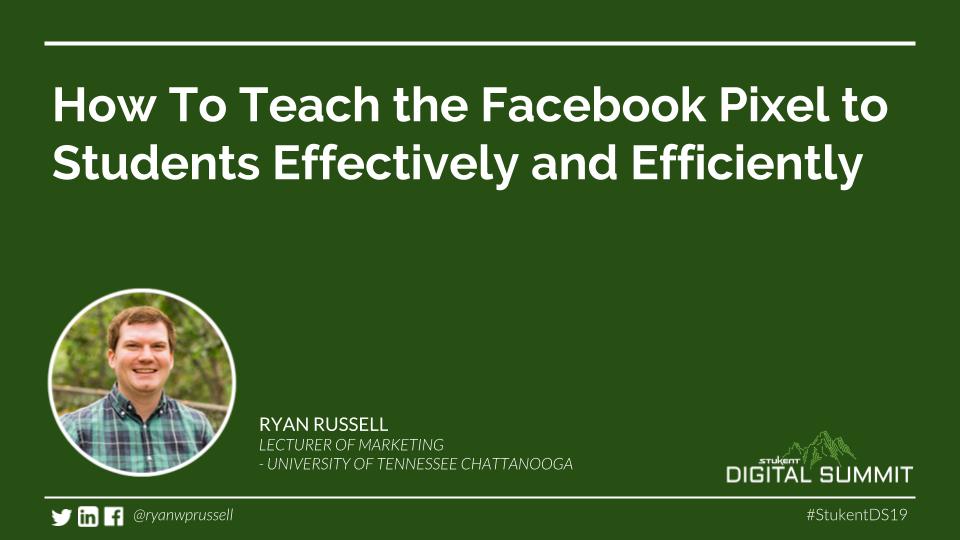
Ryan Russell
Lecturer of marketing, University of Tennessee Chattanooga
Ryan Russell, a lecturer of marketing at University of Tennessee Chattanooga, spoke of the Facebook Pixel, what he described as “a snippet of code from your Facebook Ads account that you insert into the HEAD tags of your website” that can help businesses track conversions, optimize ads, build targeted audiences, and remarket ads.
Russell advocated for instruction on Facebook Pixel since it can affect students’ careers; their skills involving data analytics and marketing research; and their understanding of concepts relative to consumer behavior, marketing communications, and the creative pieces of marketing.
On the topic of how to teach Facebook Pixel, Russell gave two recommendations. First, he pointed to certifications and training, specifically presenting the options of Facebook Blueprint Training; Jon Loomer’s training materials; offerings from Hootsuite Academy; and the resources of Udacity’s Digital Nanodegree. His second recommendation unfolded as he presented an outline for incorporating a class project involving a group simulation.
Russell spoke of teaching the value of Facebook advertising, saying his approach is “differentiating between social media advertising and search advertising.” He continued, “Social media advertising, I tend to tell [students is] … more who you are and search is what you’re looking for.”
He then spoke of the educational effectiveness of Digital Marketing Essentials and the Mimic Pro simulation, both available from Stukent. He also recommended the books “Nicely Said,” by Nicole Fenton and Kate Kiefer Lee, and “Everybody Writes” by Ann Handley.
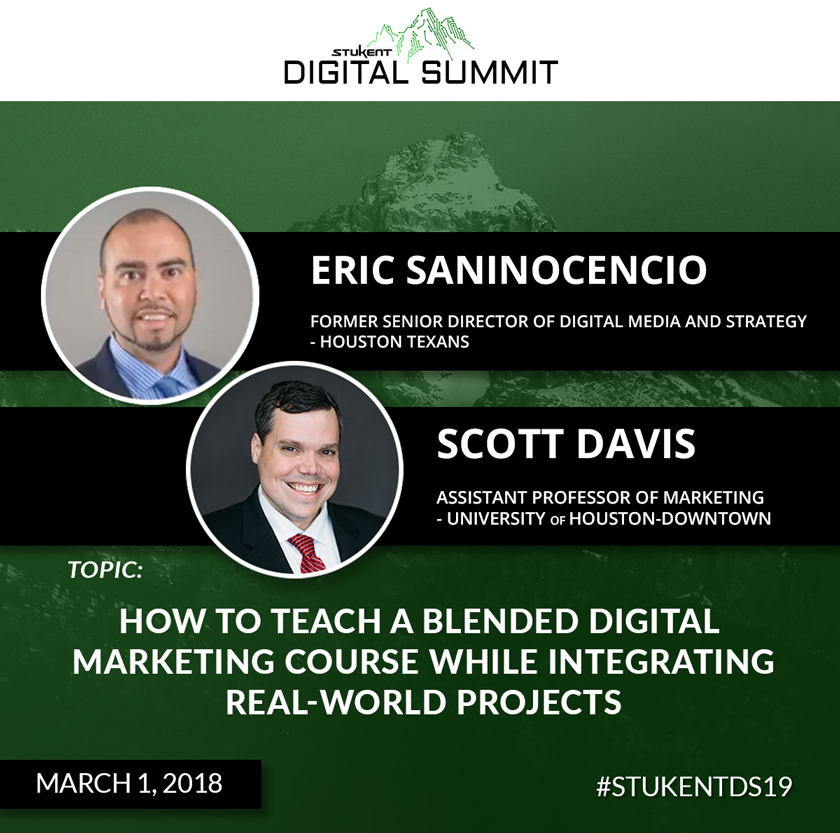
Scott Davis
Assistant professor of marketing, University of Houston-Downtown
Eric Saninocencio
Former senior director of digital media and strategy, Houston Texans
The next session focused on creating successful blended learning experiences — bringing practitioners into the classroom to present with instructors. Scott Davis and Eric Saninocencio teamed up to provide perspective and advice.
Davis is an assistant professor or marketing at University of Houston-Downtown and Saninocencio is the former senior director of digital media and strategy for the Houston Texans. They have worked together as Saninocencio has brought digital marketing expertise into Davis’ class.
In regard to marketing instruction, Davis said, “Theory is not enough.” He pointed to the value of
having industry professionals in the classroom and expressed that at his institution the “MBA program is very reality-focused,” with “practitioners in the classroom every night with the professor.”
Davis presented insight on an instructor’s responsibilities when setting up a class session that will involve an industry guest. He spoke of sharing a class script with the practitioner, including student inputs into the lesson plan, and making accommodation for the practitioner’s ideas and interests.
Saninocencio gave perspective on what a practitioner can do to prepare for the classroom experience. He suggested that practitioners review material before class, consider what would make the presentation memorable, and plan with the instructor to create a well-constructed presentation.
Both presenters promoted the value of an instructor and visiting practitioner building a relationship before presenting in class together.
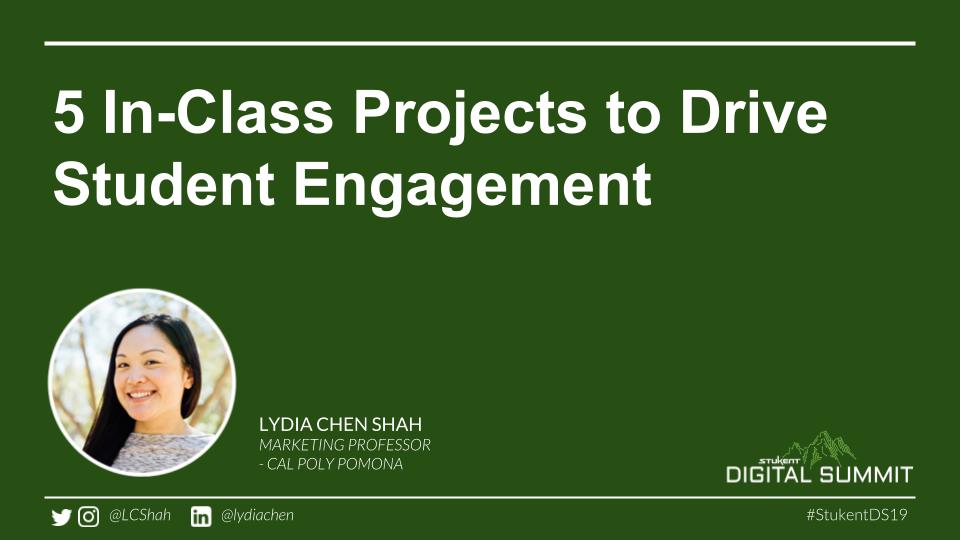
Lydia Chen Shah
Marketing professor, California State Polytechnic University, Pomona
California State Polytechnic University, Pomona marketing professor Lydia Chen Shah talked of incorporating engaging projects into the classroom. Specifically, she presented ideas relative to these five projects:
- Landing Page Analysis
- Analytics via Google Trends
- Paid Search Ad Copy
- Content Marketing Research
- #Instafamous Influencer
She said these projects are “about critical thinking and pushing students to apply lessons learned, immediately, and also in a very safe environment.”
In setting up projects, she suggested going forward with a fun topic, “or you can have your students help you pick examples, things that are relatable to them.” She also talked of projects building on earlier class activities to aid students in making connections and of using “live examples” that are not-well researched prior to class but that allow students and the instructor to take part in an activity together.
Chen Shah also talked of three aspects of in-class projects, the first being that students, who come to class with various degrees of knowledge, are brought together. The second aspect is that students can receive feedback in the classroom, “their practice bubble.” Third, Chen Shah talked of having fun with the projects.
During a question-and-answer segment following her formal presentation, Chen Shah indicated that she does not tell students when these projects will be presented in class.
She also shared that in addition to requiring Stukent’s Digital Marketing Essentials digital textbook for her digital marketing course she encourages students to subscribe to “Think with Google” reports or eMarketer.
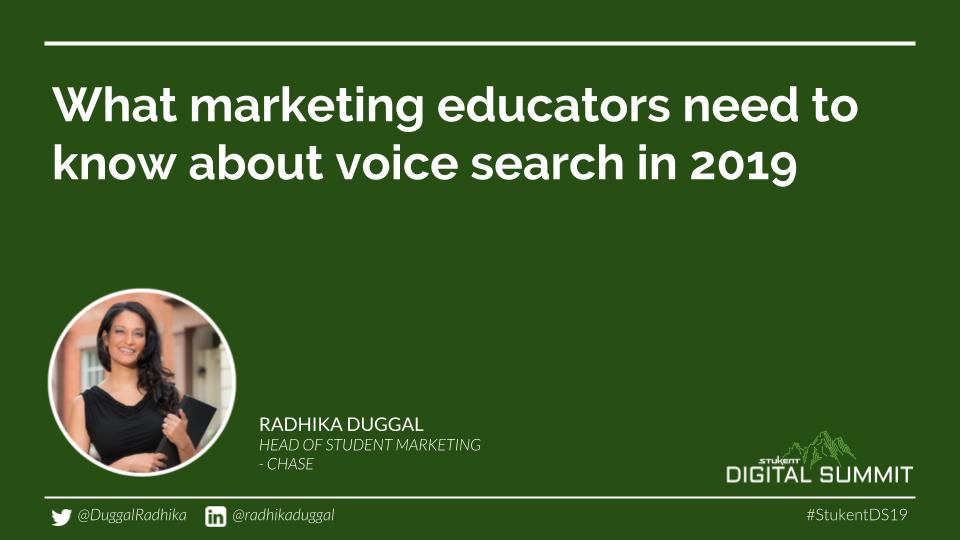
Radhika Duggal
Head of student marketing, JP Morgan Chase; adjunct instructor, New York University
The final summit speaker, Radhika Duggal, spoke of her topic in the context of a changing consumer behavior landscape. She focused on voice — what she said is “one of those newest changes that I truly believe is going to have a significant impact on consumer behavior.”
The head of student marketing at JP Morgan Chase and an adjunct instructor at New York University, Duggal identified “voice” as “a software application” that allows internet interaction by a means other than keyboard, mouse, or phone.
Duggal referenced a behavioral shift among consumers, pointing out that within three years voice has garnered a 50 percent adoption rate in the United States. She said that people use voice to search for general information, make purchases, teach children, integrate with a Fitbit or Apple Watch, and turn on devices.
During the presentation, Duggal framed this question to session attendees: “How do we make sure that [students] are prepared with an understanding of those new trends as they go out into the market place and search for jobs?”
She said that when it comes to instruction on voice, instructors should present the facts behind the demand for voice, what marketers do with those facts, and how those facts impact consumer behavior. Duggal also indicated her idea to bring a voice device into class so that her students can directly experience voice as a factor impacting consumer behavior.
In addition to working with Stukent through her role as a conference speaker, Duggal has authored Consumer Behavior, a Stukent digital textbook that is available now.
Spring 2019 Stukent Digital Summit
The Spring 2019 Stukent Digital Summit marks the third in a series of virtual conferences that gather educators for presentations on digital marketing instruction. Click here for access to the Spring 2019 Stukent Digital Summit presentations.






